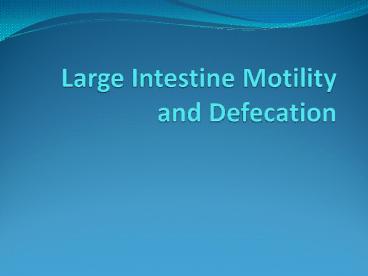Large Intestine Motility and Defecation PowerPoint PPT Presentation
1 / 28
Title: Large Intestine Motility and Defecation
1
Large Intestine Motility and Defecation
2
Objectives
- Describe the functions of the colon
- Describe the movement of fecal matter through the
colon to the rectum - Describe the duodenal and gastrocolic reflexes
- Explain the defecation reflexes and the factors
that initiate and regulate them - Describe secretion in the large intestine
- Describe absorption in the GI tract
3
Movement of Chyme into the Cecum
- Ileocecal sphincter feedback control
- Peristalisis in the ileum
- Reflex control from the cecum
- Distension of the cecum
- Irritants in the cecum (e.g. inflamed appendix)
- Control
- Via myenteric plexus
- Prevertebral sympathetic ganglia
4
Functions of the Colon
- Absorption of water and electrolytes (proximal)
- Storage of fecal matter (distal)
5
Absorption in the Large Intestine
- Absorption of sodium and chloride creates an
osmotic gradient for absorption of water - Can absorb 5-8 liters of fluid and electrolytes
daily - Aldosterone greatly potentiates sodium absorption
- Most of the water and electrolytes in chyme that
enters the colon is absorbed - Active absorption of sodium, creating a gradient
for absorption of chloride
6
Fluid and Electrolyte Absorption Role of
Transporters
7
Absorption of Sodium
8
(No Transcript)
9
Ingestion, Secretion and Absorption in the GI
Tract
10
Movement of the Colon
- Normally sluggish
- Two types
- Mixing movements (Haustrations)
- Haustrations bulging of the large intestine
into baglike sacs as a result of circular and
longitudinal muscle contraction - Propulsive movements (Mass movements)
11
Mixing Movements - Haustrations
- Large circular constrictions (similar to
segmentations in the small intestine) - 2.5 cm of circular muscle contracts along with
the longitudinal muscle - Haustrations
- Up to 90 seconds long (with peak activity at
approx. 30 sec) - Increases exposure to fecal material and enhances
absorption - Responsible for some of the propulsion in the
cecum and ascending colon
12
Propulsive (Mass) Movements
- Modified peristalisis
- Constrictive ring occurs in response to distended
or irritated point in the colon - 20 or more cm of colon distal to the constrictive
ring contract together (as a unit) - Fecal material is thus propelled further down the
colon - For 30 sec the contraction is forceful, then
relaxation for 2-3 minutes - Followed by another mass movement
13
Mass Movements
- Series of mass movements persists for 10-30 min
- Mass movements propel chyme from the cecum to the
sigmoid colon - Occur 1 to 3 daily, especially during the first
hour following a meal - When a mass of feces is forced into the rectum,
there is a desire to defecate
14
Movement of the Colon
15
Reflexes Affecting Mass Movements
- Gastrocolic reflex stimulatory
- Distention of the stomach
- Duodenocolic reflex - stimulatory
- Distention of the small intestine
- Both reflexes transmitted by autonomic nervous
system - Mass movements also initiated by irritation in
the colon (e.g. ulcerative colitis)
16
- Most of the time the rectum is empty
- Due to weak functional sphincter (20 cm from
anus, at junction of the sigmoid colon and the
rectum) - Sharp angulation of the rectum
17
Defecation
- When mass movement forces feces into the rectrum
- Immediate desire to defecate
- Reflex contraction of rectrum
- Relaxation of anal sphincter
- Approx. 80 to 200 mL of fecal matter expelled
daily
18
Defecation
- Tonic constriction by
- Internal anal sphincter (circular smooth muscle)
- External anal sphincter (striated voluntary
muscle) - Controlled by pudendal nerve (somatic NS)
- Voluntary control
19
Mader, 5th edition
20
Defecation Reflexes
- Intrinsic reflex
- Local enteric nervous system (myenteric plexus)
- Distension of rectal wall
- Peristaltic waves in descending colon, sigmoid
and rectum - Relaxation of internal anal sphincter (inhibitory
action of the myenteric plexus) - Weak when functioning alone
- Parasympathetic defecation reflex
- Involves sacral segments of the spinal cord
- Pelvic nerves
21
Defecation and the Parasympathetic Nervous System
- Signals transmitted into spinal cord
- Reflex back to descending colon, sigmoid, rectum
and anus (pelvic nerves) - Intensify peristalisis
- Relax internal anal sphincter
22
Defecation
- Relaxation of the external anal sphincter is
voluntary - Defecation reflexes can be purposely activated
- Forcing fecal particles into the rectum to cause
new reflexes - Not as effective as the natural reflexes
- From the spinal cord, defecation signals also
have the following effects - Taking deep breath
- Closure of glottis
- Contraction of abdominal wall muscles
- Relaxation and movement of pelvis floor downward
23
Secretions of the Large Intestine
- Crypts of Lieberkuhn, but no villi
- Mainly mucous cells
- Mucus
- Bicarbonate ions
- Regulated by tactile stimulation and local
reflexes to the mucous cells
- Mucus in the large intestines
- Protects intestinal wall against excoriation
- Adherent medium for fecal particles
- Protects wall from bacterial activity (within the
feces) - Provides barrier against acidity
24
Secretion of Water and Electrolytes
- Irritation
- Eg. Bacterial infection (enteritis)
- Mucosa secretes large amount of water and
electrolytes - Secretion of mucus
- Rapid movement of fecal particles, i.e. diarrhea
25
Composition of Feces
- Three-fourths water
- One-fourth solid matter
- 30 dead bacteria
- 10-20 fat
- 10-20 inorganic matter
- 2-3 protein
- 30 undigested roughage (e.g. bile pigment,
sloughed epithelial cells)
26
(No Transcript)
27
(No Transcript)
28
References
- Guyton and Hall, 2006. Textbook of Medical
Physiology. Chapter 63, 64, 65.

